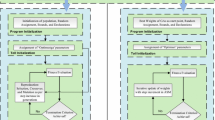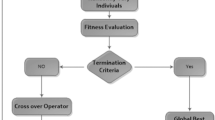Abstract
In this study, an advance computational intelligence scheme is designed and implemented to solve third-order nonlinear multiple singular systems represented with Emden–Fowler differential equation (EFDE) by exploiting the efficacy of artificial neural networks (ANNs), genetic algorithms (GAs) and active-set algorithm (ASA), i.e., ANN–GA–ASA. In the scheme, ANNs are used to discretize the EFDE for formulation of mean squared error-based fitness function. The optimization task for ANN models of nonlinear multi-singular system is performed by integrated competency GA and ASA. The efficiency of the designed ANN–GA–ASA is examined by solving five different variants of the singular model to check the effectiveness, reliability and significance. The statistical investigations are also performed to authenticate the precision, accuracy and convergence.












Similar content being viewed by others
References
Lane HJ (1870) On the theoretical temperature of the sun, under the hypothesis of a gaseous mass maintaining its volume by its internal heat and depending on the laws of gases as known to terrestrial experiment. Am J Sci 148:57–74
Emden R (1907) Gaskugeln Teubner. Leipzig und Berlin
Ahmad I et al (2017) Neural network methods to solve the Lane–Emden type equations arising in thermodynamic studies of the spherical gas cloud model. Neural Comput Appl 28(1):929–944
Baleanu D, Sajjadi SS, Jajarmi A, Asad JH (2019) New features of the fractional Euler–Lagrange equations for a physical system within non-singular derivative operator. Eur Phys J Plus 134(4):181
Luo T, Xin Z, Zeng H (2016) Nonlinear asymptotic stability of the Lane–Emden solutions for the viscous gaseous star problem with degenerate density dependent viscosities. Commun Math Phys 347(3):657–702
Rach R, Duan JS, Wazwaz AM (2014) Solving coupled Lane–Emden boundary value problems in catalytic diffusion reactions by the Adomian decomposition method. J Math Chem 52(1):255–267
Boubaker K, Van Gorder RA (2012) Application of the BPES to Lane–Emden equations governing polytropic and isothermal gas spheres. New Astron 17(6):565–569
Taghavi A, Pearce S (2013) A solution to the Lane–Emden equation in the theory of stellar structure utilizing the Tau method. Math Methods Appl Sci 36(10):1240–1247
Khan JA et al (2015) Nature-inspired computing approach for solving non-linear singular Emden-Fowler problem arising in electromagnetic theory. Connect Sci 27(4):377–396
Bhrawy AH, Alofi AS, Van Gorder RA (2014) An efficient collocation method for a class of boundary value problems arising in mathematical physics and geometry. In: Abstract and Applied Analysis, vol 2014. Hindawi Publishing Corporation
Ramos JI (2003) Linearization methods in classical and quantum mechanics. Comput Phys Commun 153(2):199–208
Dehghan M, Shakeri F (2008) Solution of an integro-differential equation arising in oscillating magnetic fields using He’s homotopy perturbation method. Prog Electromagn Res 78:361–376
Radulescu V, Repovs D (2012) Combined effects in nonlinear problems arising in the study of anisotropic continuous media. Nonlinear Anal Theory Methods Appl 75(3):1524–1530
Flockerzi D, Sundmacher K (2011) On coupled Lane–Emden equations arising in dusty fluid models. In: Journal of Physics: Conference Series, vol 268, no 1. IOP Publishing, p 012006
Ghergu M, Radulescu V (2007) On a class of singular Gierer-Meinhardt systems arising in morphogenesis. Comptes Rendus Mathématique 344(3):163–168
Wazwaz AM (2015) Solving two Emden–Fowler type equations of third order by the variational iteration method. Appl Math Inf Sci 9(5):2429
Shawagfeh NT (1993) Non perturbative approximate solution for Lane–Emden equation. J Math Phys 34(9):4364–4369
Wazwaz AM (2001) A new algorithm for solving differential equations of Lane–Emden type. Appl Math Comput 118(2):287–310
Liao S (2003) A new analytic algorithm of Lane–Emden type equations. Appl Math Comput 142(1):1–16
He JH, Ji FY (2019) Taylor series solution for Lane–Emden equation. J Math Chem 57(8):1932–1934
Nouh MI (2004) Accelerated power series solution of polytropic and isothermal gas spheres. New Astron 9(6):467–473
Mandelzweig VB, Tabakin F (2001) Quasilinearization approach to nonlinear problems in physics with application to nonlinear ODEs. Comput Phys Commun 141(2):268–281
Ahmad I et al (2019) Novel applications of intelligent computing paradigms for the analysis of nonlinear reactive transport model of the fluid in soft tissues and microvessels. Neural Comput Appl 31(12):9041–9059
Fateh MF et al (2019) Differential evolution based computation intelligence solver for elliptic partial differential equations. Front Inf Technol Electron Eng 20(10):1445–1456
Ahmad I et al (2019) Design of computational intelligent procedure for thermal analysis of porous fin model. Chin J Phys 59:641–655
Raja MAZ et al (2016) A new numerical approach to solve Thomas-Fermi model of an atom using bio-inspired heuristics integrated with sequential quadratic programming. Springer Plus 5(1):1400
Umar M et al (2019) Intelligent computing for numerical treatment of nonlinear prey–predator models. Appl Soft Comput 80:506–524
Raja MAZ, Shah FH, Tariq M, Ahmad I (2018) Design of artificial neural network models optimized with sequential quadratic programming to study the dynamics of nonlinear Troesch’s problem arising in plasma physics. Neural Comput Appl 29(6):83–109
Jafarian A, Mokhtarpour M, Baleanu D (2017) Artificial neural network approach for a class of fractional ordinary differential equation. Neural Comput Appl 28(4):765–773
Raja MAZ, Shah FH, Alaidarous ES, Syam MI (2017) Design of bio-inspired heuristic technique integrated with interior-point algorithm to analyze the dynamics of heartbeat model. Appl Soft Comput 52:605–629
Ghehsareh HR, Zaghian A, Zabetzadeh SM (2018) The use of local radial point interpolation method for solving two-dimensional linear fractional cable equation. Neural Comput Appl 29(10):745–754
Raja MAZ, Niazi SA, Butt SA (2017) An intelligent computing technique to analyze the vibrational dynamics of rotating electrical machine. Neurocomputing 219:280–299
He W, Chen Y, Yin Z (2016) Adaptive neural network control of an uncertain robot with full-state constraints. IEEE Trans Cybern 46(3):620–629
Schaff JC, Gao F, Li Y, Novak IL, Slepchenko BM (2016) Numerical approach to spatial deterministic-stochastic models arising in cell biology. PLoS Comput Biol 12(12):e1005236
Pelletier F, Masson C, Tahan A (2016) Wind turbine power curve modelling using artificial neural network. Renew Energy 89:207–214
Zameer A et al (2017) Intelligent and robust prediction of short term wind power using genetic programming based ensemble of neural networks. Energy Convers Manag 134:361–372
Zúñiga-Aguilar CJ, Coronel-Escamilla A, Gómez-Aguilar JF, Alvarado-Martínez VM, Romero-Ugalde HM (2018) New numerical approximation for solving fractional delay differential equations of variable order using artificial neural networks. Eur Phys J Plus 133(2):75
Rizaner FB, Rizaner A (2018) Approximate solutions of initial value problems for ordinary differential equations using radial basis function networks. Neural Process Lett 48(2):1063–1071
Ghasemi S, Nazemi A (2019) A fractional power series neural network for solving a class of fractional optimal control problems with equality and inequality constraints. Netw Comput Neural Syst 30(1–4):148–175
Holland JH (1992) Genetic algorithms. Sci Am 267(1):66–73
Srinivas N, Deb K (1994) Muilti-objective optimization using no dominated sorting in genetic algorithms. Evol Comput 2(3):221–248
Mehmood A et al (2019) Integrated computational intelligent paradigm for nonlinear electric circuit models using neural networks, genetic algorithms and sequential quadratic programming. Neural Comput Appl. https://doi.org/10.1007/s00521-019-04573-3
Chang FS, Wu JS, Lee CN, Shen HC (2014) Greedy-search-based multi-objective genetic algorithm for emergency logistics scheduling. Expert Syst Appl 41(6):2947–2956
Majeed K et al (2017) A genetic algorithm optimized Morlet wavelet artificial neural network to study the dynamics of nonlinear Troesch’s system. Appl Soft Comput 56:420–435
Vaishnav P, Choudhary N, Jain K (2017) Traveling salesman problem using genetic algorithm: a survey. Int J Sci Res Comput Sci Eng Inf Technol 2(3):105–108
Raja MAZ, Shah AA, Mehmood A, Chaudhary NI, Aslam MS (2018) Bio-inspired computational heuristics for parameter estimation of nonlinear Hammerstein controlled autoregressive system. Neural Comput Appl 29(12):1455–1474
Duvvuri SP, Anmala J (2019) Fecal coliform predictive model using genetic algorithm-based radial basis function neural networks (GA-RBFNNs). Neural Comput Appl 31(12):8393–8409
Mehmood A et al (2018) Design of neuro-computing paradigms for nonlinear nanofluidic systems of MHD Jeffery-Hamel flow. J Taiwan Inst Chem Eng 91:57–85
Baroudi U, Bin-Yahya M, Alshammari M, Yaqoub U (2019) Ticket-based QoS routing optimization using genetic algorithm for WSN applications in smart grid. J Ambient Intell Humaniz Comput 10(4):1325–1338
Mehmood A et al (2019) Integrated intelligent computing paradigm for the dynamics of micropolar fluid flow with heat transfer in a permeable walled channel. Appl Soft Comput 79:139–162
Neysiani BS, Soltani N, Mofidi R, Nadimi-Shahraki MH (2019) Improve performance of association rule-based collaborative filtering recommendation systems using genetic algorithm. Int J Inf Technol Comput Sci 2:48–55
Ahmadi MH, Ahmadi MA, Nazari MA, Mahian O, Ghasempour R (2019) A proposed model to predict thermal conductivity ratio of Al2O3/EG nanofluid by applying least squares support vector machine (LSSVM) and genetic algorithm as a connectionist approach. J Therm Anal Calorim 135(1):271–281
Deuerlein JW, Piller O, Elhay S, Simpson AR (2019) Content-based active-set method for the pressure-dependent model of water distribution systems. J Water Resour Plan Manag 145(1):04018082
Azizi M, Amirfakhrian M, Araghi MAF (2019) A fuzzy system based active set algorithm for the numerical solution of the optimal control problem governed by partial differential equation. Eur J Control 54:99–110
Koehler S, Danielson C, Borrelli F (2017) A primal-dual active-set method for distributed model predictive control. Optimal Control Appl Methods 38(3):399–419
Wang X, Pardalos PM (2017) A modified active set algorithm for transportation discrete network design bi-level problem. J Glob Optim 67(1–2):325–342
Shen C, Zhang LH, Yang WH (2016) A filter active-set algorithm for ball/sphere constrained optimization problem. SIAM J Optim 26(3):1429–1464
Stam CJ, Reijneveld JC (2007) Graph theoretical analysis of complex networks in the brain. Nonlinear Biomed Phys 1(1):3
Bullmore E, Sporns O (2009) Complex brain networks: graph theoretical analysis of structural and functional systems. Nat Rev Neurosci 10(3):186–198
Cao J, Xiao M (2007) Stability and Hopf bifurcation in a simplified BAM neural network with two time delays. IEEE Trans Neural Netw 18(2):416–430
Raja MAZ, Khan JA, Zameer A, Khan NA, Manzar MA (2019) Numerical treatment of nonlinear singular Flierl-Petviashivili systems using neural networks models. Neural Comput Appl 31:2371–2394
Munir A, Manzar MA, Khan NA, Raja MAZ (2019) Intelligent computing approach to analyze the dynamics of wire coating with Oldroyd 8-constant fluid. Neural Comput Appl 31(3):751–775
Raja MAZ, Mehmood J, Sabir Z, Nasab AK, Manzar MA (2019) Numerical solution of doubly singular nonlinear systems using neural networks-based integrated intelligent computing. Neural Comput Appl 31(3):793–812
Author information
Authors and Affiliations
Corresponding author
Additional information
Publisher's Note
Springer Nature remains neutral with regard to jurisdictional claims in published maps and institutional affiliations.
Rights and permissions
About this article
Cite this article
Sabir, Z., Umar, M., Guirao, J.L.G. et al. Integrated intelligent computing paradigm for nonlinear multi-singular third-order Emden–Fowler equation. Neural Comput & Applic 33, 3417–3436 (2021). https://doi.org/10.1007/s00521-020-05187-w
Received:
Accepted:
Published:
Issue Date:
DOI: https://doi.org/10.1007/s00521-020-05187-w




